|
www.3-DLegends.com
Preserving stereoscopic history of extraordinary people who have enriched our lives
|
|
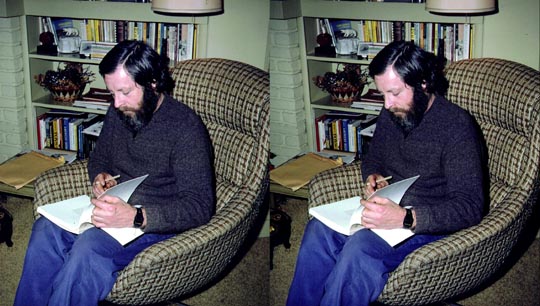
|
Remembering
Peter E. Palmquist
1936-2003
|
Peter Palmquist signing one of his books at the home of NSA Board Chairman
Lou Smaus in 1982. (Stereo by Susan Pinsky)
Stereoscopic Immortality
The title Peter choose for his keynote speech at the 1993 NSA
convention in San Diego—"Stereoscopic Immortality"—could
all too easily be seen as prophetic. He was talking, in fact, about an
immortality created through the sharing of images and knowledge with
generations to come. He stressed the point that this can only happen if
the images and information remain intact, in some logical order, and
accessible to anyone interested.
Tagged "stereoscopic" to fit the NSA audience, his prescription for
immortality applied to images of any format or source and went far
beyond just leaving behind a tidy collection in acid-free boxes. He
went over the need to identify the subject and maker of each image as
far as possible. Well documented subjects or photographers could then
be shared through essays, articles, exhibits or even projected slide
shows.
A good part of the second half of Peter's talk dealt with insuring that
collections and any research surrounding them survive the eventual
demise of the collector. A mention in a will or casual instructions to
relatives generally fail the cause of immortality, and his
recommendations went as far as visiting museums, libraries or
universities to arrange a permanent repository for your collection
where it would be appropriately protected, cataloged and made
available. Some in the audience may have felt he was expecting a lot of
them, but his advice came nowhere near the level of commitment to
photographic history that he had already made personally, and had
literally built his life around.
|
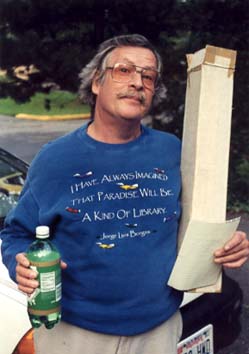 |
|
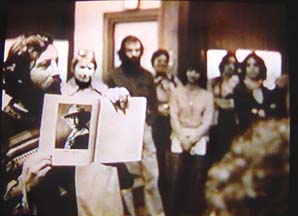
Peter making a presentation as historian
|
After leaving the army in 1960 (he was a photographer at Allied
Headquarters in Paris), Peter attended Humboldt State University in
California, received a B.A. in art and was employed as the university
photographer for 28 years. In 1971, to quote from the obituary
distributed by his family:
Peter stopped by an antique store in McKinleyville, where the owner
asked him what he collected. His response? "Nothing." She asked him
what he did for a living. When he explained he was a photographer, she
gave him "a fist full" of old
photographs, taken by local photographers
completely unknown to him.The rest is history.
That fistful of photographs blossomed into a passion and an obsession.
At his death, he had amassed more than 150,000 images, including scores
of rare images from the earliest days of western American photography
and some 50,000 photographs documenting more than 100 years of history
in Humboldt County, California. With tremendous enthusiasm, he recently
transferred his extensive collection of images and research materials
to the Beinecke Rare Book and Manuscript Library at Yale University.
.
|
Peter retired from Humboldt State in 1989 to devote full time to
research, writing and collecting. Of the 340 articles he wrote for
various publications, 22 were for Stereo World. His article "The
Stereographs of Peter Britt," Stereo World, vol. 9, no. 2, earned the
1983 NSA award for the best historical article. In 1987 he was awarded
Fellow of the NSA for Distinguished Scholarship and Extraordinary
Knowledge of Stereoscopy. His honors, professional appointments and
assignments from other photographic and historical organizations and
publications literally go on for pages.
He published over 60 books (one with the NSA, Lawrence &
House-worth/Thomas Houseworth & Company: A Unique View of the West
1860-1886) and gave lectures all over the country throughout his
career. None of this was achieved with any "professional" academic
credentials or doctorates as any sort of historian, yet his
contributions to photographic history went far beyond the work of even
the most dedicated amateur, the most obsessive collector, or the most
passionate dilettante.
Peter's ultimate goal wasn't the acquisition of images and knowledge,
but the sharing of whatever he was able to unearth. He never let the
constraints of finances, time or institutional procedures interfere
with that, and in the process his efforts surpassed those of many well
paid academics with large staffs. Asked why he never acquired any
academic credentials, he once replied, "I would rather spend my life
working on the material than running around trying to get a doctorate.
I let my work speak for itself."
The quantity and quality of that work loudly proclaim authentic immortality.
- John Dennis, Editor - Stereo World magazine, National Stereoscopic Association
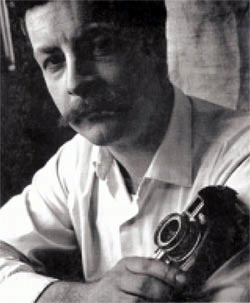 A Dynamo of Activity and Information
A Dynamo of Activity and Information
Peter was an exhaustive researcher who scoured libraries and historical
society archives for decades to tease out every fact he could from
primary sources on photographers in the West and women photographers.
He lectured extensively throughout the world. He was the
editor-in-chief of Photographers: A Sourcebook for Historical Research,
past editor of The Daguerreian Annual, contributing editor or on the
editorial board of Journal of the West, The Photographic Historian, The
Californians, The Journal of California and Great Basin Anthropology.
Peter published hundreds of books, articles and papers on many
different aspects of photography. His latest project was his Women in
Photography International Archive, the intent of which was to cover
every facet of the participation of women in photography from the
beginning to the present.
Peter was a giant in our world, a meticulous, caring, ubiquitous dynamo
of activity and information who cast treasure after treasure into our
community. I will miss him.
- Carl Mautz, Mautz Publishing, Nevada City, CA
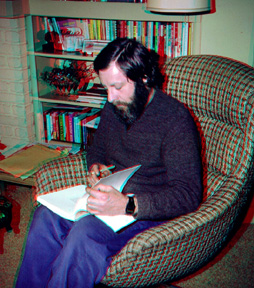
|
Deeper Lives
Peter Palmquist was our friend for over 20 years. He was profoundly
sensitive, fascinating, considerate and generous. Peter's love of
sharing his knowledge, his interests, his enthusiasm and his intellect
were unequaled. He gave so much more to the world, both in photographic
history and in appreciation for life. His books, his work on historical
photographers and daguerreotypes, his contributions will live on, but
his physical presence will always be missed. I'm sure there are many of
us who never told him how much we loved him, because we just never
imagined he would be gone so soon, but we did love you, Peter. Our
lives are deeper, more interesting and fuller for having known you.
Bless you, Peter, wherever you are.
- Susan Pinsky & David Starkman, Culver City, CA
|
|
Lend A Hand
I knew of Peter long before I met him. In the early 1980s I subscribed
to American West magazine, in which I kept seeing fascinating articles
on early Western photographers by a guy named Peter E. Palmquist. I
also noticed that he was listed as the magazine's photo editor. "What a
cool job," I mused. Clearly, this fellow was passionate about what he
did, and had fun doing it! At the end of that decade, I finally got to
meet Peter at a Daguerreian Society symposium. He immediately struck me
as a warm, helpful person who would make the time for you if you had a
question. In the following months, John Graf, president of the society,
told me that Peter was working to establish an annual publication and
asked if I would assist him. At first, I'm sure Peter had me on
"double-secret probation"...would I be a useless appendage, or a real
contributor? In the end, we had a productive and enjoyable three-year
run together as the publication's editor and associate editor. After
that gig fizzled out, Peter and I agreed that we worked together as a
team too well to simply go our separate ways. We tinkered with ideas:
Could we establish a serial publication on early photography? Write
magazine articles or a book-length biography? We settled on the idea of
writing a biographical encyclopedia of early California photographers.
He would ship me boxes of his notes (guaranteed to keep the U.S. Postal
Service solvent for years), and I'd shape them up into biographical
entries. Months into the project, Peter called one day. "You know," he
said, "since we're doing California, we really need to cover Nevada as
well, because most of the early Nevada photographers came from
California." Fine. Months more passed. "You know," Peter suggested, "it
makes a lot of sense to include Oregon, too." Every month he would add
a new state, territory, or country. "If it's March, it must be
Guatemala." Birthing that book was at times a difficult process as we
struggled to invent a format that was our own. Peter asked me one day,
"Have you come to the point yet where you absolutely hate the
manuscript?" "Yes," I replied. "Good," he chuckled. "That's a sure sign
we're halfway finished with it." His sense of humor often helped me get
through trying days. Before Peter was finished working his wicked
powers of persuasion on me, we had covered North America west of the
Mississippi River. The results were the books Pioneer Photographers of
the Far West and the forthcoming Pioneer Photographers from the
Mississippi River to the Rocky Mountains. By some twist of fate, we
actually had finished the last of the text of the latter book on the
same day Peter left Arcata on that final trip to Emeryville.
A few years ago, one drizzly February day, I rode with Peter and Pam to
the foothills where he lived as a child near Ferndale, California. He
pointed to a patch of wild-flowers (daffodils?) growing along the
roadside and said that those were a sure indication that a
long-vanished pioneer homestead once stood on the site. Peter may have
"vanished" physically, but the seeds he sowed in his lifetime have
sprouted a rich and beautiful bounty that photo-researchers will long
benefit from. To me, Peter was a mentor, confidante, colleague,
collaborator, and dear friend. He was like a father to many of us. The
best thing we as photo-historians can do to honor and remember Peter is
to advance the field of research and strive to do it with the passion,
conviction, and benevolence that he evinced. And when someone comes to
you with an earnest question or request, please lend a hand if possible.
So, Peter, I will see you at the next destination. As you liked to say, "more anon."
- Thomas R. Kailbourn
Footsteps of Original Research
I feel I must also express the sense of loss to our community. When I
read the news yesterday, I hoped that a miracle would happen because I
could not imagine the field of photo history without Peter. Everything
he did was original research and we are all indebted to him. The Amon
Carter Museum, in particular, benefited enormously from his research on
Carleton Watkins for our exhibition in 1983. That was before my tenure
here, but was the first time I visited here, driving up from Austin for
the symposium. In recent years, I made sure that our library acquired
every book by Peter. I just checked our catalog and it lists 45 titles.
I
cannot imagine anyone else being able to follow in his footsteps.
- Barbara McCandless, Curator of Photographs Amon Carter Museum
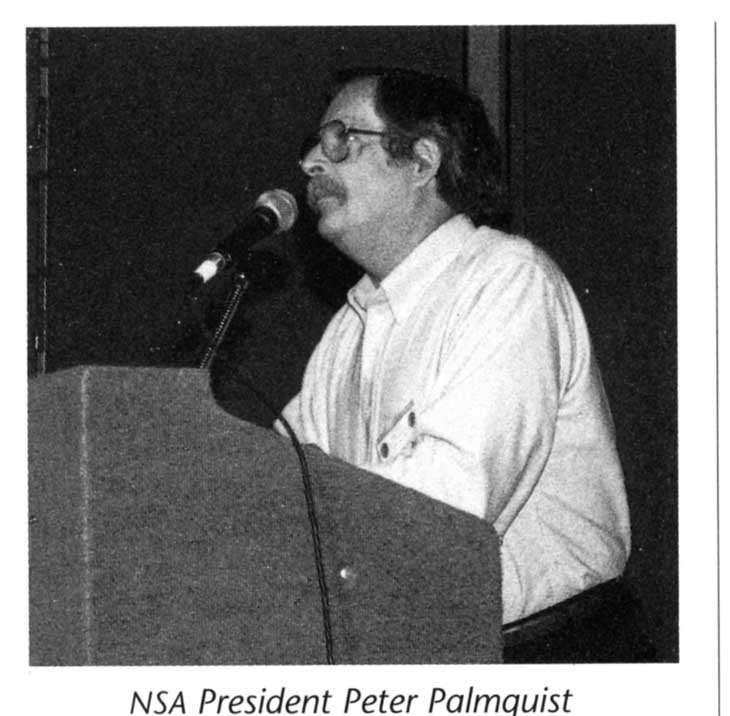
Footnotes
There were many times when I contacted Peter for research help—
usually on female photographers, Watkins, & Shew. He always tried
to take the time to be helpful. I am also someone who receives similar
requests & know how hard it is to find the time and offer answers.
He always amazed me with his effort to do so. At least as we do books
& articles in the future, we will often indeed be remembering him
with one the best memorials possible: our footnote references to his
many research findings!
- Larry West
A Measure of PEP
Two things I adored about Peter Palmquist: He was an absolute original.
He had an unwavering conviction in the importance of his work. I wish a
greater measure of these things for all of us—it's the least we
can do in Peter's absence. Out in California, we started calling him
PEP, after his initials and his energy. PEP was a fun guy but could
drive you to distraction with his questions and his unflagging
insistence on getting things right. Of course that always came in handy
later, when you needed to do some fact checking. He was very generous
about inviting people up to Arcata and I always
wanted to go see if his house was made out of file cabinets with a roof
on top and if he used file folders for a blanket. How did he keep track
of everything? Where did he put it all? Peter was an amazing person and
it's a stunning blow to lose him this way.
- Kate Ware, Philadelphia Museum of Art
The Power of Honesty
Peter was one of those kind-hearted, generous souls that are too rarely
encountered in one's life. I was fortunate to have made his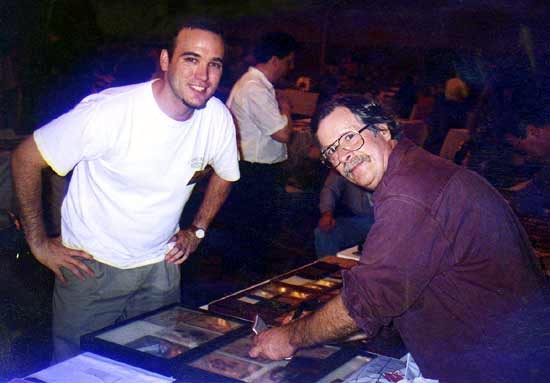 acquaintance while I was still quite young, perhaps fourteen or
fifteen. My enthusiasm for photographic history triggered my initial
contact with Peter, which evolved into a lifetime friendship. Peter was
one of those who have left an indelible mark on my consciousness. I am
particularly fond of this story:
acquaintance while I was still quite young, perhaps fourteen or
fifteen. My enthusiasm for photographic history triggered my initial
contact with Peter, which evolved into a lifetime friendship. Peter was
one of those who have left an indelible mark on my consciousness. I am
particularly fond of this story:
On one of Peter's visits to my Stockton, CA home he showed me the power
of honesty in collecting. I think I was about seventeen at the time; I
had been saving California photographer imprints for his growing
research collection. For me it was like finding new and rare butterfly
specimens for science. I delighted in discovering something that Peter
had previously not seen.
On this particular visit, as he combed over my
most recent finds, he singled out a cabinet card by San Francisco
photographer, William Shew. I wondered why he was pondering over one of
the most common imprints available. He asked "How much?" I replied, "What did I pay for it?" as I
always left my prices on the backs of these cards since in those days I
was not much of a dealer. I always sold Peter imprints at cost, and
Peter always added something extra for my effort. He replied "$2.50."
So I said, "Well then, that's the price." His next sentence stopped me
cold. "Would it still be $2.50 if I told you that the man in the
portrait was William Shew?" My seventeen-year-old brain tried to
process the situation and all I could say with a gulp was, "I guess
so." Peter laughed and said, "I would never do such a thing." And he
added "Think about what you will want for it and sell it to me when you
are ready."
From that day forward I have remembered that lesson, and have done my
very best to live by that level of character. I had been subjected to a
few underhanded dealings from the sharks in the collecting world prior
to this incident, and had begun to think this was the norm. Peter
restored my faith in collecting and in the sharing of knowledge. The
loss of Mr. Peter Palmquist can never be repaired. There was none
amongst us willing to do the difficult work that had to be done in
order to understand our pioneer photographers as a whole, and the
important contributions that they left behind. In doing this work he
joins the ranks of the brightest of those important luminaries. He was
their voice in this age, and through his work they will not be
forgotten. And so let us not forget this man who inspired so many of us
to become historians. He planted that seed in me many years ago, and I
am grateful to have been counted as one of his friends. Goodbye, old
friend.
- John McWilliams
No Longer An E-mail Away
Well over a year ago Peter Palmquist found out about my work in the
history of Indian photography. He wrote to me wanting to know
more...and that resulted in several e-mails between us. I was very
touched at his interest, very impressed by his erudite scholarship and
more importantly very inspired by all that he had to say by way of
encouragement. His enquiry and interest into the work of Indian Women
photographers inspired me to look again. Now I treasure those messages
that I wish could be held and preserved in a way more than the
electronic permits. Its sad that he is no longer an e-mail away when I
need to make an enquiry or look for a reference in the history of
contemporary photography.
- Niyatee Shinde, Mumbai, India
Beyond Academics
I first met Peter when I was an undergraduate student at Humboldt State
University in the late 70s. I loved Photo History, and only one course
was offered in it,
taught by a photo professor. Somehow I discovered that one of the best
photo historians around, lived just around the corner from me, and
worked in the Audio Visual Department of the school. Peter, my teachers
explained to me, didn't have the formal degree needed to be a faculty
member, or to teach in the Art Department. The ludicrousness of having
someone of his talent, knowledge, and dedication being relegated to the
AV Department, rather than a valued member of the faculty was not lost
on me. Today, I try to look far beyond credentials and academic
pettiness to find truly brilliant and dedicated faculty for colleagues,
and the lessons I learned from Peter's experience have never left me. I
told him once that the university's lack of acceptance and
encouragement reminded me of Erik Satie whose work was dismissed by his
colleagues, all of whom are now forgotten, while Satie's work lives on.
When I finally met him and visited his library and collection, I was
blown away. I just couldn't fathom what he had gathered, cataloged,
and researched, with almost no support... just passion and love for the
medium. It made me pause when I entered back into my "formal" classes
at the university.
He struggled for a correction and expansion of photographic history to
include greater numbers of women, a better appreciation and
understanding of the impact of the Daguerreotype, and an embrace of
regional photographers. He published a number of books and articles,
and from what I knew, it was done without much, if any financial
remuneration. It's a reminder of the impact a true scholar and
passionate advocate for the medium can have. From his home in Arcata,
he embraced a singular and highly personal struggle for the medium he
loved. I'm really going to miss him, and I know that I'm not alone.
- Harris Fogel - Chairman, Media Arts Dept.
The University of the Arts Philadelphia, PA
Commitment to Women Photographers
I am pleased to see so many people express the same sentiments I
experienced with Peter over the years. In the late 1980s soon after
arriving in Oregon, a colleague suggested I call him. What I thought
would be a brief chat turned into a lengthy discussion of ways to
approach various topics. I soon met Peter at a Women in Photography
conference in Tucson and he warmly invited me to join him and a group
for dinner. During the years I researched my Myra Albert Wiggins book,
Peter often sent thick envelopes filled with photocopies and computer
printouts of relevant information. When I wanted to pay him for the
copies, he always replied, "Just send whatever you want." He read my
40,000 word manuscript twice!
The Women in Photography (womeninphotography.org) website is
underwritten by Peter's energy and commitment to women photographers.
He understood the need to make research and information in this field
accessible to as many people as possible. His contribution to the
history of women photographers and the encouragement he provided to
others working in this area was exceptional. Peter's generosity and
spirit extended beyond photography to his family and community. He took
groups of Japanese exchange students backpacking in the Trinity
mountains and always had time to care for Pam, Rebecca, and his
children. That so many of us from around the globe share such affection
for one person, is indicative of a remarkable, unusual, and generous
individual. Thank you Peter, for giving so much to so many.
- Carole Glauber
Weed Views at NSA
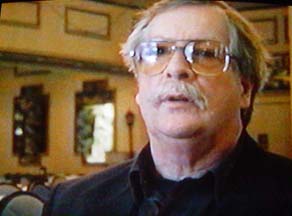
Peter was a very well respected historian, collector, researcher and
friend to many photography collectors and dealers I met Peter several
years ago, after corresponding with him many times about the early
stereo views of Yosemite. I had sold him a group of Yosemite views by
Weed that he put in the exhibit at the first Riverside NSA convention
several years ago. It was a great feeling that he put my views into
that exhibit. He was always a fair, friendly, and knowledgeable guy. He
was very active in many different clubs and organizations,.and he
always took the time to answer any question you had about early western
photographers. I always looked forward to seeing and talking to him. He
will be very much missed.
- George Polakoff Hubbard Woods IL
A Wealth of Information
Peter has been a great influence in my career, and has not only
contributed hugely to my knowledge of our field, but has inspired me
with his enthusiasm and passion. He was always just an email away, in
spite of his busy schedule, and I turned to him countless times.
I did my best to return the favors he so often granted by bringing new
acquisitions and finds within our collections to his attention, but I
know the balance was always tipped in my favor. The information and
insights he could provide always outweighed the nuggets I turned up for
his research, I'm sure. Yet, I always looked forward to his library
visits and the opportunity to share an exciting discovery. I have fond
memories of the trip I made to Arcata, finally taking him up on an
invitation repeated over several years. I am amazed by his hospitality
and generosity—knowing that he opened his home and his
collections to so many over the years. The extent of his collection was
impressive, but the thoroughness and organization of his research notes
was truly astounding—what a wealth of information gathered as a
foundation for others to build upon!
We at The Bancroft Library are collectively in his debt for the
light he shed on our holdings, his advocacy for and participation in
conservation and cataloging projects, and for the invaluable resources
that he himself created for future scholars. I know that his impact,
seen and unseen, on our institution will be a great benefit for
generations to come. I am heartbroken at the loss of a great mentor and
friend.
- James Eason
Archivist for Pictorial Collections The Bancroft Library
Watkins at the Getty
For several years Peter and I had been working as partners on a catalog
raisonne of all of the mammoth plate photographs of Carleton Watkins,
a subject of mutual interest that goes back almost thirty years for
both of us. Peter had visited the Getty many times as a consultant and
we met together dozens of times at various locations to pursue our
research. The project will continue without Peter, but it will be the
less without his contributions as we continue the process of
transforming the raw information into a book.
Peter was my very dear friend, a much respected professional colleague,
and a wonderful human being. I will miss the conversations we had about
the quirks and accomplishments of CEW. I will miss looking at mammoth
plates together, magnifying glass in hand, never failing to be
surprised by a piece of knowledge PP would bring to the conversation.
We were scheduled to meet in Berkeley on January 14 and the news of his
accident came to me there on the 13th while planning for what we would
be doing the next day. May the Lord bless and keep him.
- Weston Naef - Curator of Photographs The J. Paul Getty Museum
Max and Peter
Max is a 5 year old Pembroke Corgi. He has always been extremely tuned
in to Peter and me. When I went through my cancer treatment, he bit his
nails for a while. Every time I had chemo, he threw up once although I
didn't. He experienced radiation fatigue. Before my treatment began, I
woke up one night to find him standing with his nose in my mouth,
inhaling deeply. He then lay his head on my mediastinum, which is where
the tumor was.
Last Saturday, Peter and Max had just pulled into the parking lot of
the Emeryville apartment. On previous such occasions, we had a routine. Peter phoned from the lobby. I raced down with Max's ball and
a plastic bag for any poop. I took Max across the street to play and
pee; Peter unloaded the car. But this time I was in Sacramento. Peter
took Max across the street. As they were almost to the other side of
the street, the car hit Peter. We know the make and model of the car.
The driver actually stopped, turned around and looked, and then raced
off. Max ran back to the building to get help. Someone who didn't know
Max grabbed his leash, a woman named Tiffany. About a minute later, a
man came to tell that someone had been seriously injured. This happened
at 6:55pm. Peter was at the trauma center by 7:16. The neuro team
assured me that he never felt it, that the severity of the brain injury
was immediate.
Young Tiffany took Max home with her to her apartment. Her boyfriend
and she sat on the floor for hours with Max, talking with him as he
continued to shake. She assured him I would come home. Her parents
brought dog treats over at some point, traveling about 20 miles.
Eventually, Tiffany thought they should go to bed. She invited Max to
join them, and he leaped up onto their bed. At 4:00 in the morning, my
dear friend Bobbie arrived, got Max, and went to our apartment.
It is my own personal belief that Max KNEW Peter was gone almost
immediately. Here in Arcata, Max would usually be looking for Peter to
figure out which corner of the place Peter is in. Now he is not
looking. He is eating well, he is drinking, he is walking, and he is
even chasing his ball. Peter will be buried with Max's old collar and
with a copy of the image that was to be on our wedding announcement.
- Pam Mendelsohn Arcata, CA
(Pam Mendelsohn was Peter's partner
of 26 years. The couple had planned to marry in April, and to host a
wedding celebration in July.)
Quote by Peter from Feb. 4, 2001 video interview "Well, The real message is,
that if you're passionate about anything, that's kinda what life's about. so,
whatever your idea is, whatever you want to pursue, do it whole heartedly and
don't ever let anybody tell you,can't....fine, you can do it."
Max, Peter's best
friend. Max was with Peter when he was hit by the car
Peter
Palmquist photo: Nancy Clendaniel/Renton, WA, October 1997
Sweat
Shirt reads: I Have Always Imagined That Paradise Will Be A Kind Of
Library .. Jorge Luis Borges
Peter is holding a box with a Women in
Photography International Expo poster -special Royal Photographic Society
edition, circa 1991, Bath, UK.Poster, photographed and created by WIP Member and WIPI Expo participant - Val Valandans

|
The Peter E. Palmquist Memorial Fund for
Historical Photographic Research
The Peter E. Palmquist Memorial Fund for Historical
Photographic Research has a double emphasis: the study of
under-researched women photographers internationally (past and present)
and Western American photographers before 1900. Awards will be made
biannually to independent researchers based on their
application/proposal.
In addition, grant recipients will be asked to provide the Palmquist
Fund's advisory board with a copy of any published work that results
from their grant. The Yale University Library has agreed to add that
copy to its permanent collections to complement the resources of the
Peter E. Palmquist Collection of Western American and Women's
Photography at the Beinecke Rare Book & Manuscript Library.
The fund will be a combination endowment and expendable one. Obviously,
all contributions are fully tax-deductible. The application process,
due dates, etc. will be announced shortly.
The Humboldt Area Foundation, located in Bayside, California, was
created in 1972. It is a community foundation that has been actively
involved in creating endowments and expendable funds to serve a broad
variety of interests and needs. Grants and awards can be made
worldwide. The Peter E. Palmquist Memorial Fund for Historical
Photographic Research will join a family of over 400 funds.
Donations can be sent to: Humboldt Area Foundation, PO Box 99, Bayside,
CA 95524. Checks should be made payable to the Humboldt Area Foundation
and indicate Peter Palmquist Memorial Fund in the lower left corner.
Any questions, please call: Alexandra Reid, Director of Donor Services
at 707-442-2993, x302; email is alexreid@hafoundation. |
|
www.3-DLegends.com
Preserving stereoscopic history of extraordinary people who have enriched our lives
|

 A Dynamo of Activity and Information
A Dynamo of Activity and Information

 acquaintance while I was still quite young, perhaps fourteen or
fifteen. My enthusiasm for photographic history triggered my initial
contact with Peter, which evolved into a lifetime friendship. Peter was
one of those who have left an indelible mark on my consciousness. I am
particularly fond of this story:
acquaintance while I was still quite young, perhaps fourteen or
fifteen. My enthusiasm for photographic history triggered my initial
contact with Peter, which evolved into a lifetime friendship. Peter was
one of those who have left an indelible mark on my consciousness. I am
particularly fond of this story: